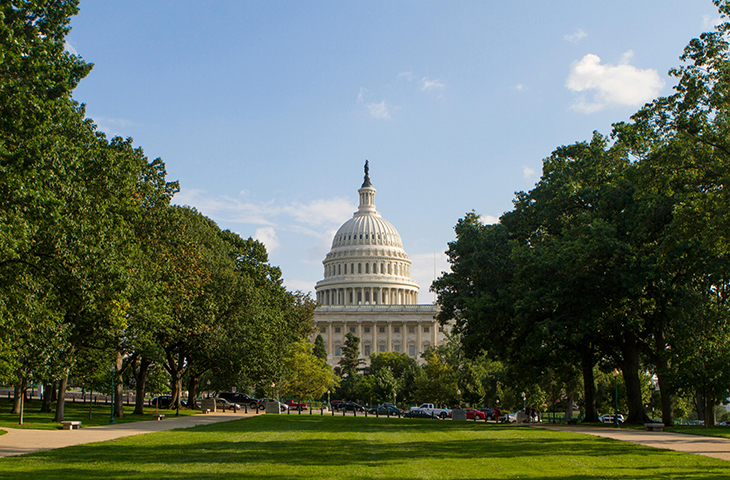How A Trump Administration Crackdown On Foreign Students Unraveled

It took more than 100 lawsuits and 50 restraining orders from dozens of federal judges. But after 20 days of court losses, the Trump administration capitulated, reversing a decision that threatened the legal status of thousands of foreign students in the United States.
The Trump administration’s abrupt move, announced by a Justice Department lawyer in court Friday, tacitly acknowledged what judges in two dozen states had been saying since early April: Terminating university students’ immigration records from a federal database — a step which appeared to jeopardize their legal authorization to remain in the country — was almost certainly illegal. And it was implemented so ham-handedly that judges felt compelled to intervene.
“It’s just kind of sinking in for all those students that they’re now going to be OK,” said Brian Green, an attorney for more than 50 students affected by the terminations. “This was not decision-making. This was injustice.”
The whiplash-inducing turnabout was a fresh setback for the administration’s aggressive crackdown on foreign students and for President Donald Trump’s broader immigration agenda, which has been mired in legal challenges. Courts have blocked or forced the administration to reverse core policies on deportations of purported gang members, refugee admissions, legal status for hundreds of thousands of Venezuelans and other efforts to hurriedly remove immigrants from the country. Those setbacks have come at all levels of the court system and centered on the administration’s alleged efforts to sidestep due process requirements enshrined in the Constitution.
The mass termination of students’ legal records is the latest in that line of challenges.
In early April, colleges and universities began notifying some foreign students studying in the country and admitted under so-called F-1 visas, that Immigration and Customs Enforcement officials had “terminated” their student status, preventing them from continuing to study. Many of those students had minor brushes with the law in recent years that fell short of the legal standard to revoke a foreign student’s authorization to remain in the United States.
One woman in Connecticut said she was targeted after a dispute over an airline worker’s attempt to charge her $100 for a carry-on bag. A student in Alaska claimed his record was canceled because he was once accused of boarding a bus that was out of service. Another was cited by police for driving too slowly. Some students said they had no idea why they were targeted.
On Friday, when the Trump administration agreed to reverse the policy, it acknowledged that the terminations were the result of linking the students’ immigration records with a national FBI database that logs encounters with law enforcement, no matter how insignificant.
The results were both bizarre and, for the students, terrifying. Students with years-old DUIs, misdemeanor gambling charges, traffic violations and other minor infractions learned their immigration status had been canceled. In some instances, the schools told the students they could face immediate deportation. And as lawsuits began to pile up, the Justice Department compounded their fear further, with government lawyers saying they couldn’t verify whether those students remained in the country legally.
Judges recoiled at the lack of information, ordering the administration in several individual cases to undo the damage and restore the students’ records to the immigration database, known as SEVIS. On Friday, the administration said it would restore the canceled records and no longer terminate students’ files based solely on information pulled from the FBI’s criminal record system.
Lawyers for the students are convinced it was the result of some kind of automated setup, perhaps driven by AI, noting that ICE is in the process of manually reinstating students’ records one by one, despite the mass termination that occurred in early April. Though this might have been elucidated further in court proceedings, the administration’s reversal may short-circuit further inquiries.
A flood of lawsuits and rankled judges
Since April 5, federal courts across the country have been inundated with more than 100 lawsuits stemming from these terminations. A review of the cases by POLITICO revealed that before Friday’s capitulation, courts had issued at least 54 restraining orders, with judges growing increasingly exasperated with the administration’s refusal to explain the basis — and effect — of its moves.
At issue is a decision by ICE officials to mark as “terminated” the records of thousands of international students in a federal database that verifies their authorization to study in the United States. Students whose approvals were removed from this database say their schools blocked them from completing their studies and warned that they could be subject to deportation. And the Trump administration, in court case after court case, refused to say whether those students remain in the country legally, deepening students’ fears that they could be detained and deported.
“You're standing here today on behalf of the United States and you're telling me that you do not know whether this plaintiff is legally in the United States? How is she supposed to know the answer to that question if you don't?” U.S. District Judge Sparkle Sooknanan wondered aloud at a hearing in Washington Monday.
ICE officials’ actions appear distinct from the efforts by Trump administration officials to target foreign student activists such as Columbia’s Mahmoud Khalil. Secretary of State Marco Rubio invoked a rarely used statute to seek to deport Khalil over actions Rubio deemed contrary to American policy interests.
Rather, this new wave of cases centers on students studying at U.S. colleges and universities, many in specialized fields such as engineering, mathematics or science, or participating in advanced research — in some cases just weeks from graduation. These students are studying in the United States through a program that began under the 1952 Immigration and Nationality Act known as the F-1 system. That system is part of a long-running effort by the U.S. government to attract and train highly skilled foreign students, many of whom ultimately remain in the United States.
Before reversing course Friday, the Trump administration insisted the students were exaggerating the gravity of the situation and raising alarm over what amounted to bookkeeping decisions confined to an internal ICE database. But when pressed, Justice Department lawyers said they simply don’t know — because ICE won’t tell them — whether those students could stay in the country.
“I think the government has been and is playing games,” Sooknanan said at a hearing Friday just before granting a restraining order in one of the student cases.
Judges appointed by presidents of both parties — including at least one appointed by Trump himself — have nearly all sympathized with the students’ plight. One labeled the situation "Kafkaesque." Another said the Trump administration had offered “literally nothing” to suggest it had a legitimate basis to strip these students’ legal status. A third briefly threatened to hold the Justice Department in contempt until ICE confirmed it had restored a student’s status.
Others were gobsmacked that the Justice Department could not provide a straight answer when asked if these students were considered at risk of deportation because of their change in status.
“This is not a man trying to evade this country's laws. He’s trying to comply with them,” U.S. District Judge Tanya Chutkan told a Justice Department lawyer in Washington on Wednesday. “You’re putting him in an impossible situation.”
And the rejections aren’t just coming from Washington, California and other liberal bastions. Judges have issued full or partial restraining orders in 23 states, including Arizona, Indiana, Iowa, Montana, Ohio, New Hampshire, Pennsylvania, South Carolina, South Dakota and Georgia, where one judge shielded 133 affected students in a single lawsuit.
The F-1 immigration system
The students fighting to continue their studies were admitted to the United States under what is known as F-1 status.
When foreign nationals want to attend American universities, their first step is to apply to their chosen schools. If the schools accept them, they send the prospective students immigration forms to present to their local U.S. consulates. Once approved by the State Department, those future students are granted an F-1 visa to present to Customs and Border Protection officials upon arrival in the United States.
Those admitted under this system are permitted to stay in the United States as long as they comply with a few rules: Maintain a full-time course load at their school; refrain from employment except for jobs connected to their schooling; commit no violent felonies.
After they graduate, some may choose to extend their legal stay through school-sanctioned research and employment or permanent residency through a U.S. employer. Others may choose instead to return to their home countries.
To track those admitted to the U.S. under this system, the Department of Homeland Security maintains a database known as the Student and Exchange Visitor Information System, or SEVIS. It was mandated by Congress in the wake of the 1993 World Trade Center bombing — and expanded by the Patriot Act after 9/11 — to track foreign students.
The administration’s response to legal challenges
The administration has downplayed ICE’s actions, claiming they’re minor bookkeeping adjustments that don’t, at least immediately, impact students’ immigration status. Justice Department lawyers say those edits to an internal database aren’t subject to these broad legal challenges. Instead, they say, the students could only seek relief under the Privacy Act.
That leads to what some judges have described as a catch-22. The Privacy Act is only available to U.S. citizens, green card holders and citizens of the UK and European Union. For most of the students caught up in the current wave of terminations, it offers no legal recourse.
DOJ lawyers also say students can use a procedure to request reinstatement of their SEVIS record, but immigration attorneys say that requires the students to acknowledge that their status was lawfully terminated. The rules also bluntly declare: “If the Service does not reinstate the student, the student may not appeal that decision.”
Lawyers for the students say the administration’s effort to trivialize the SEVIS terminations ignores how it has played out in reality: Students are being held out of classes, are already in jeopardy of losing career opportunities and being warned that they are accumulating days of “unlawful presence” in the United States, which could fuel deportation efforts or their ability to seek other legal immigration statuses in the future.
Who is being targeted?
Elika Shams, an Iranian citizen, is a student at the University of Connecticut in her second year of a biomedical engineering PhD program.
“On December 31, 2024, Elika was rushing to meet a connecting flight when Frontier Airlines staff refused to let her board unless she paid $100 for a carry-on bag. When she questioned this, Frontier staff shut the gateway door. Elika attempted to open the door to explain she would pay, resulting in a warning from TSA,” according to a lawsuit she filed.
Shams had to stop working part-time on campus after the SEVIS termination. UConn also told her on April 15 that she could no longer attend classes or perform research — a move that appeared to put her at risk of deportation, the lawsuit says.
Jean Kashikov, a native of Kazakhstan living in former Gov. Sarah Palin’s hometown of Wasilla, Alaska, graduated from the University of Alaska Anchorage last December with degrees in math and professional piloting. He was working as a flight instructor under the “Optional Practical Training” work-permit program for students and recent graduates when he got an email from the university on April 10.
“I am terribly sorry to inform you that this morning, your record was marked as ‘terminated’ … indicating that the U.S. government believes you have violated your status,” the school wrote. “Please note that all employment authorization, including OPT, ends immediately when you fall out of valid status, and that unauthorized employment will make you ineligible for immigration reinstatement, so please cease any employment immediately.”
Kashikov was given no specific reason for the suspension, but a lawsuit he filed suggests it may be linked to an episode in 2022 in Arizona where he was charged with disorderly conduct, obstructing a highway and criminal trespass based on what his lawsuit calls “an attempt to board a city bus that the driver alleged was out of service.” The charges were eventually dismissed, court records show.
The judges siding with the administration
A handful of judges have sided with the administration in the early rounds of litigation. Some rejected restraining orders on technical grounds, noting that the Trump administration needed more time to respond to the students’ claims. Just one judge issued a detailed ruling aligning with the administration. U.S. District Judge Stephen Murphy, a George W. Bush appointee based in Michigan, said the student plaintiffs had not convinced him they would be permanently harmed by the SEVIS terminations. The Justice Department has been quick to share his opinion with other courts across the country.
Murphy said the lack of clarity about whether students are deportable works in the administration’s favor. He said the students “failed to fully explain” whether they could legally remain in the country, despite the SEVIS termination and whether they were attempting to seek reinstatement. Murphy also said it was conceivable that schools could allow students to continue taking classes — though in numerous cases, students indicated their schools said they were no longer eligible.
“To be sure, some Plaintiffs have future plans that might be impeded,” Murphy wrote. “But those harms are sufficiently distant to counsel against immediate relief.”
In most cases, when pressed by judges, Justice Department lawyers have been unable to say whether a student with a terminated SEVIS record is legally allowed to remain in the country and continue their schooling — even if they’re weeks from graduation.
In recent days, the Justice Department lawyer who has handled a significant share of the F-1 student cases told multiple judges that he has been asking ICE for clarity but has not received a response.
“He’s either here legally or he’s not here legally,” an exasperated U.S. District Judge Ana Reyes said at a hearing in Washington last week. “There is a yes or no answer here. … This is not Schrodinger’s visa, either he’s here legally or he’s not here legally.”


